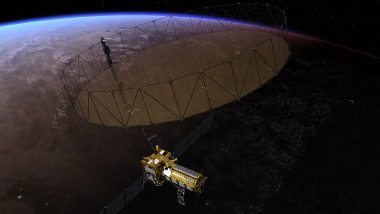Mumbai, August 14: In mission updates provided by the National Aeronautics and Space Administration (NASA) about the collaboration with the Indian Space Research Organisation (ISRO), the launch of the NASA-ISRO joint Synthetic Aperture Radar (NISAR) Mission has suffered a delay. The launch has been pushed to sometime beyond February 2025 instead of the previously targeted 2024 due to orbital constraints. As per the official mission site, when launched, NISAR would be "the first satellite mission to use two different radar frequencies (L-band and S-band) to measure changes in our planet's surface less than a centimetre across".
NASA and ISRO signed the collaboration back in 2014, and the NISAR mission was targeted to launch this year in 2024. While NASA was to provide the L-band synthetic aperture radar, GPS receivers and a solid-state recorder and payload data sub-system for the mission, ISRO's contribution was to provide the the S-band radar, the spacecraft bus and launch vehicle as well as the associated launching services.
Know the Mission Objectives of NISAR
NISAR, a joint mission between #NASA🤝🏻#ISRO.
Here's a detailed video about the mission's objectives.
The launch can be expected in the coming months🚀 pic.twitter.com/NbQTofdpSg
— ISRO InSight (@ISROSight) January 9, 2024
Cause of Delay of NASA-ISRO NISAR Mission
The primary reason cited for the delay of the NASA-ISRO NISAR Mission are orbital constraints and the ongoing work on the spacecraft's antenna. Addressing the concerns about temperature fluctuations due to alternating sunlight and shadows that might potentially affect NISAR's boom and radar antenna reflector are crucial before the launch. The antenna is currently under construction in California, USA. Its further tempering would be done in India later by ISRO. The satellite will be reintegrated with the radar system at ISRO’s Bengaluru facility after all tests are conducted. Gaganyaan Mission: ISRO and NASA Partner With US-Based Private Company Axiom Space To Send 1 Gaganyatri to International Space Station.
Mission Objectives of NISAR
This joint mission of NASA and ISRO will measure Earth’s changing ecosystems, dynamic surfaces with ice masses providing information about the planet's biomass, natural hazards, sea level rise and groundwater levels. NISAR will observe Earth’s lithosphere and cryosphere with a 12-day regularity on ascending and descending passes as well as sample Earth on average every six days for a baseline three-year mission. Signs of Life Found on Mars? NASA Mars InSight Lander Discovers Underground Reservoir of Liquid Water on Red Planet.
The NISAR mission will provide critical data required to study environmental changes and natural hazards, which will further the knowledge required to mitigate the harmful consequences of climate change and make disaster management more resilient.
(The above story first appeared on LatestLY on Aug 14, 2024 05:17 PM IST. For more news and updates on politics, world, sports, entertainment and lifestyle, log on to our website latestly.com).













 Quickly
Quickly





















